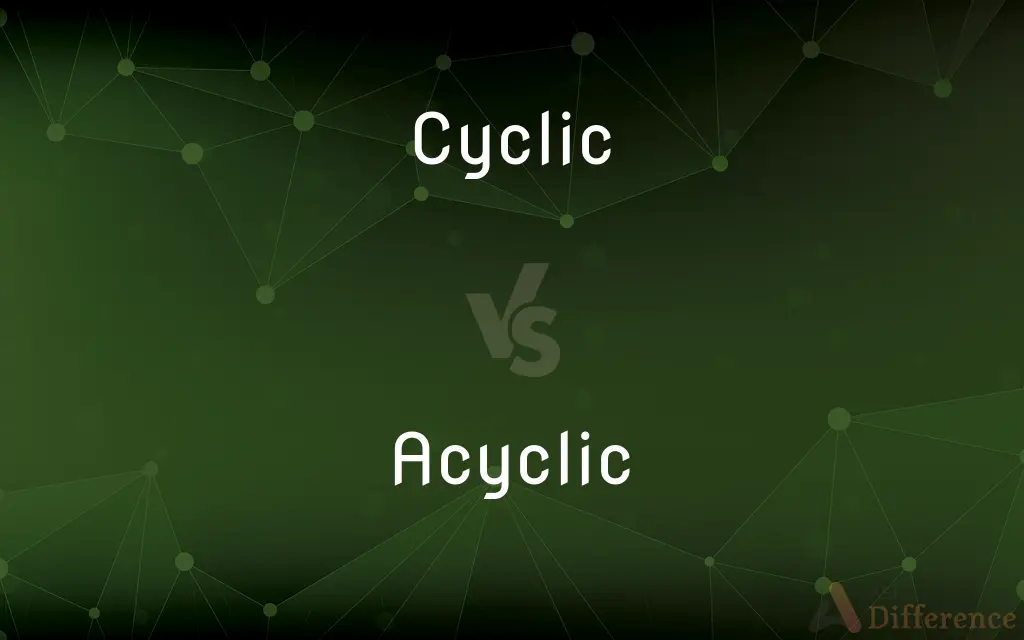Cyclic vs. Acyclic — What's the Difference?
By Maham Liaqat & Urooj Arif — Updated on March 17, 2024
Cyclic compounds contain rings of atoms, whereas acyclic compounds consist of open chains without rings.

Difference Between Cyclic and Acyclic
Table of Contents
ADVERTISEMENT
Key Differences
Cyclic compounds are characterized by the presence of one or more rings of atoms within their molecular structure, forming closed loops. These rings can be made of carbon atoms exclusively or can include other elements, known as heterocycles. On the other hand, acyclic compounds, also known as aliphatic compounds, do not contain any rings in their structure, consisting instead of straight or branched chains of atoms.
The physical and chemical properties of cyclic compounds can differ significantly from those of acyclic compounds due to the ring strain and the spatial arrangement of the atoms. While cyclic structures can impose constraints on the molecules, leading to unique reactivity and stability, acyclic compounds tend to have more flexibility in their structure, which can influence their reactivity and physical properties.
Cyclic compounds are often found in many biologically active molecules, such as hormones, vitamins, and antibiotics, indicating their importance in biological processes. Acyclic compounds, meanwhile, are prevalent in fats, oils, and many synthetic polymers, highlighting their versatility in both natural and industrial contexts.
Synthesis of cyclic compounds can involve strategies to form the ring structure, which can be more complex compared to the synthesis of acyclic compounds. The synthesis of acyclic compounds generally involves linear or branched chain-building reactions, which can be simpler in terms of the steps required to construct the molecule.
The stability of cyclic compounds can be influenced by the size of the ring and the presence of substituents, with certain ring sizes being more favorable due to less ring strain. Acyclic compounds do not have ring strain but can exhibit conformational isomerism, which allows for a variety of spatial arrangements.
ADVERTISEMENT
Comparison Chart
Basic Structure
Contain one or more rings of atoms
Consist of open chains of atoms without rings
Examples
Benzene, cyclohexane
Butane, hexene
Physical Properties
Often have higher boiling points due to ring strain
Usually have lower boiling points
Chemical Reactivity
Unique reactivity due to the constrained ring structure
More flexible, leading to a broader range of reactions
Biological Role
Found in hormones, vitamins, antibiotics
Prevalent in fats, oils, and synthetic polymers
Synthesis
May involve complex ring-forming strategies
Generally involves simpler linear or branched chain-building reactions
Compare with Definitions
Cyclic
Compounds with one or more rings of atoms.
Benzene is a cyclic compound with a six-carbon ring.
Acyclic
Compounds with open chains of atoms.
Octane is an acyclic compound with a straight chain of carbon atoms.
Cyclic
Often have constrained molecular structures.
Cyclohexane adopts a chair conformation to minimize strain.
Acyclic
Lack ring strain but can have conformational isomerism.
Butane has different conformations due to rotation around C-C bonds.
Cyclic
Found in biologically active molecules.
Steroids are cyclic compounds with important biological functions.
Acyclic
Prevalent in fats, oils, and polymers.
Polyethylene is a synthetic polymer made from acyclic hydrocarbons.
Cyclic
Can include heteroatoms in rings.
Pyridine is a cyclic compound with a nitrogen atom in the ring.
Acyclic
Undergo a broad range of chemical reactions.
Acyclic alkenes are highly reactive in addition reactions.
Cyclic
Characterized by ring strain and unique reactivity.
Cyclopropane is known for its ring strain and reactivity.
Acyclic
Exhibit flexibility in their structure.
Alkanes are acyclic and can have various chain lengths and branching.
Cyclic
Occurring in cycles; regularly repeated
The cyclic pattern of the last two decades
Acyclic
Not displaying or forming part of a cycle.
Cyclic
Relating to a circle or other closed curve.
Acyclic
(of a compound or molecule) containing no rings of atoms
Simple acyclic alkenes
Cyclic
(of a compound) having a molecular structure containing one or more closed rings of atoms
A cyclic sulphonium salt
Acyclic
(Botany) Not cyclic. Used especially of flowers whose parts are arranged in spirals rather than in whorls, as in magnolias.
Cyclic
(of a flower) having its parts arranged in whorls.
Acyclic
(Chemistry) Having an open-chain molecular structure rather than a ring-shaped structure.
Cyclic
Of, relating to, or characterized by cycles
A cyclic pattern of weather changes.
Acyclic
(chemistry) Not cyclic; having an open chain structure.
Cyclic
Recurring or moving in cycles
Cyclical history.
Acyclic
Containing no cycles.
Cyclic
(Chemistry) Of or relating to compounds having atoms arranged in a ring or closed-chain structure.
Acyclic
(botany) Of a flower, having its parts inserted spirally on the receptacle.
Cyclic
Having parts arranged in a whorl.
Acyclic
Not cyclic; not disposed in cycles or whorls
Cyclic
Forming a whorl.
Acyclic
Botany; not cyclic; especially having parts arranged in spirals rather than whorls
Cyclic
Characterized by, or moving in cycles, or happening at regular intervals.
The weather had a cyclic pattern of rain and sun.
Acyclic
Chemistry; not cyclic; having an open chain structure
Cyclic
Having chains of atoms arranged in a ring.
Benzene and cyclohexane are both cyclic compounds.
Cyclic
(botany) Having parts arranged in a whorl.
Cyclic
Being generated by only one element.
Cyclic
Able to be inscribed in a circle.
Cyclic
Firing at its full cyclic rate.
Cyclic
(aviation) The flight control used to control a helicopter's direction and rate of horizontal movement by tilting the lift vector of the helicopter's main rotor disk.
Cyclic
Of or pertaining to a cycle or circle; moving in cycles; as, cyclical time.
Cyclic
Having atoms bonded to form a ring structure. Opposite of acyclic.
Cyclic
Recurring in cycles{2}; having a pattern that repeats at approximately equal intervals; periodic. Opposite of noncyclic.
Cyclic
Marked by repeated cycles{2}.
Cyclic
Conforming to the Carnot cycle
Cyclic
Botany; forming a whorl or having parts arranged in a whorl;
Cyclic petals
Cyclic flowers
Cyclic
Of a compound having atoms arranged in a ring structure
Cyclic
Recurring in cycles
Cyclic
Marked by repeated cycles
Common Curiosities
Can acyclic compounds be converted into cyclic compounds?
Yes, through chemical reactions that induce the formation of rings, acyclic compounds can be transformed into cyclic compounds.
Why are cyclic compounds important in biology?
Cyclic compounds are crucial in biology due to their role in hormones, vitamins, and antibiotics, impacting various biological processes.
What is ring strain?
Ring strain is a type of strain in cyclic compounds caused by the geometric constraints of the ring, affecting the compound's stability and reactivity.
Are all cyclic compounds aromatic?
Not all cyclic compounds are aromatic; aromaticity requires specific criteria, such as a continuous ring of p-orbitals, not just the presence of a ring.
How do acyclic compounds differ from cyclic compounds in structure?
Acyclic compounds consist of open chains of atoms without any rings, in contrast to the closed-loop structures of cyclic compounds.
What role do acyclic compounds play in industrial applications?
Acyclic compounds are essential in various industrial applications, including the production of synthetic polymers, lubricants, and fuels.
Why are cyclic compounds with certain ring sizes more stable?
Cyclic compounds with certain ring sizes, like six-membered rings, are more stable due to minimized ring strain, resulting in favorable spatial arrangements.
What defines a cyclic compound?
Cyclic compounds are characterized by the presence of one or more rings of atoms in their molecular structure.
How does the presence of a ring affect a compound's properties?
The ring structure can impose constraints on a compound, affecting its stability, reactivity, and physical properties due to ring strain.
Can acyclic compounds exhibit isomerism?
Yes, acyclic compounds can exhibit conformational isomerism due to the flexibility of their chain structure, allowing for different spatial arrangements.
How does the synthesis of cyclic and acyclic compounds differ?
The synthesis of cyclic compounds often involves complex strategies to form rings, while acyclic compound synthesis typically involves simpler chain-building reactions.
How do acyclic compounds contribute to everyday products?
Acyclic compounds are key components in everyday products like plastics, fuels, and various synthetic materials, due to their versatility and reactivity.
What is the significance of heteroatoms in cyclic compounds?
Heteroatoms in cyclic compounds can significantly alter their chemical properties and reactivity, making them important in various chemical reactions and applications.
What challenges arise in the synthesis of cyclic compounds?
The synthesis of cyclic compounds can be challenging due to the need for precise conditions to form stable ring structures without causing unwanted side reactions.
What is conformational isomerism?
Conformational isomerism is a form of isomerism where molecules with the same structural formula have different spatial orientations due to rotations around single bonds.
Share Your Discovery

Previous Comparison
Ketohexose vs. Hexose
Next Comparison
Insincere vs. DisingenuousAuthor Spotlight
Written by
Maham LiaqatCo-written by
Urooj ArifUrooj is a skilled content writer at Ask Difference, known for her exceptional ability to simplify complex topics into engaging and informative content. With a passion for research and a flair for clear, concise writing, she consistently delivers articles that resonate with our diverse audience.














































